How to turn a Raspberry Pi into a NAS with OpenMediaVault
The Raspberry Pi is small, works quietly, and can connect to your home network. So it's no surprise that the Raspberry Pi NAS box is a popular Pi project. Luckily, using a Raspberry Pi as a NAS box has never been easier. Using a Linux distribution called OpenMediaVault, you can quickly and easily create a Raspberry Pi NAS box.
How to use Raspberry Pi as a NAS box
This is a pretty simple project. You'll download OpenMediaVault, install it on your Raspberry Pi, tweak some settings, and plug in external storage devices. For this project, you'll need a Raspberry Pi, the usual peripherals (monitor, keyboard, mouse, microSD card), and a computer with an SD card reader. Naturally, you'll also need USB storage devices - preferably self-powered ones with plenty of storage space for all the content you need.
Step 1: Download OpenMediaVault
Download the Raspberry Pi version of the operating system here. The downloaded file will be named omv_rpi2_rpi3_3.0.63.img.gz or something like that (the numbers at the end of the file name will change with future updates).
Step 2: Extract the disk image
Use your favorite program to unzip files - 7zip used article.
Step 3: Burn the OpenMediaVault disk image to the microSD card
In the past, make tech easier than ever to do this with another operating system - check out our guide to installing an operating system for a Raspberry Pi for more details - but you can do it under any circumstances. any way you want. Disk Utility of Mac or Win32 Disk Imager of Windows will be useful tools.
Step 4: Connect everything and launch Pi
Insert the microSD card into the Pi and connect the Pi to the local network using an Ethernet cable. Of course, you'll also want to plug in your external storage devices. Then go ahead and plug in the Pi power supply. You will find that there is no real installation and that the Pi should be up and running again without any trouble.
Step 5: Set up OpenMediaVault
When you start up your Raspberry Pi NAS, OpenMediaVault will output your IP address:
To manage the system, visit the OpenMediaVault web control panel:
eth0: [địa chỉ IP]Record and then return to the computer. Open a browser on your computer and enter the IP address of the Pi. You should see the control panel for your new Raspberry Pi NAS. Sign in with your credentials: admin (username), openmediavault (password) and do some configuration!
Step 6: Mount the drives
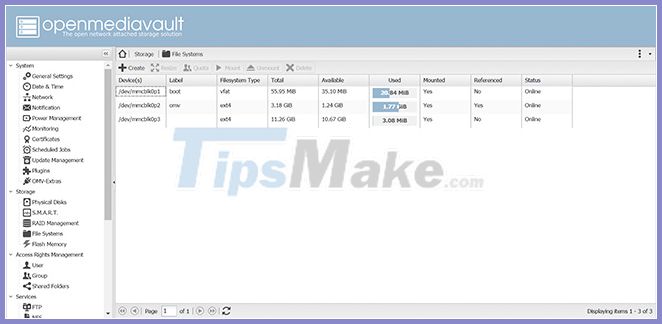 Mount the drives
Mount the drives
On the left menu, click File Systems (located under the heading Storage ). You should see your USB storage devices in the Device (s) column . Just choose one and (assuming your device is not mounted yet) hit Mount , then select Apply. It's done!
Step 7: Create shared folders
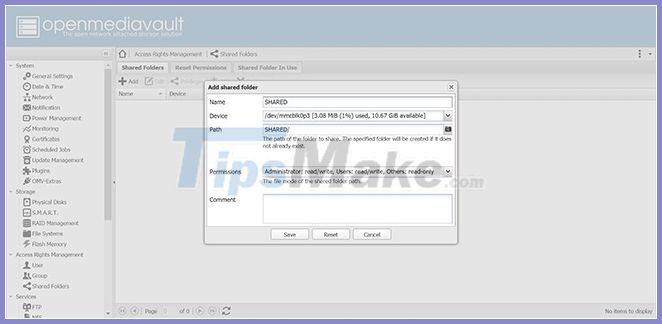 Create shared folders
Create shared folders
The purpose of this project is to deliver files to multiple devices on the network. To do that, you need to create shared folders.
Back in the main navigation menu, click Shared Folders . It will be under Access Rights Management . Just press Add to get started - you'll be able to name a folder, choose the storage device it will be on, and specify the path (you can also keep the name as the path). Click Save when you are finished.
Step 8: Turn on SMB / CFIS
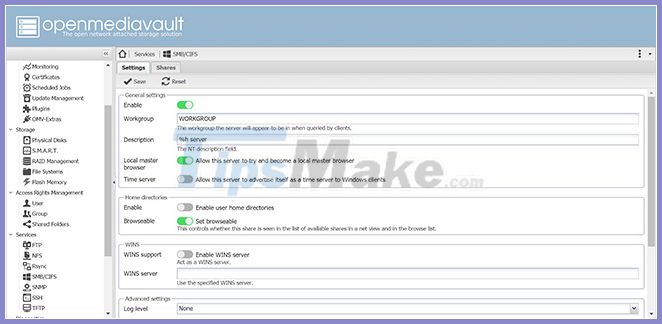 Turn on SMB / CFIS
Turn on SMB / CFIS
Creating shared folders is only half the battle. Now, you need to enable SMB / CFIS so that other computers on the network can access the shared folders. This is easy: Go back to the main menu, click on SMB / CFIS (under Services ) and enable the option labeled Enable. Then click Save> Apply .
There are two tabs for the SMB / CFIS menu . You will be on Settings , but switch to Shares. Click Add and then, in the drop-down menu, select the shared folder you created in the previous step. Click Save , then repeat as needed until all shared folders are really shared!
Step 9: Add the user
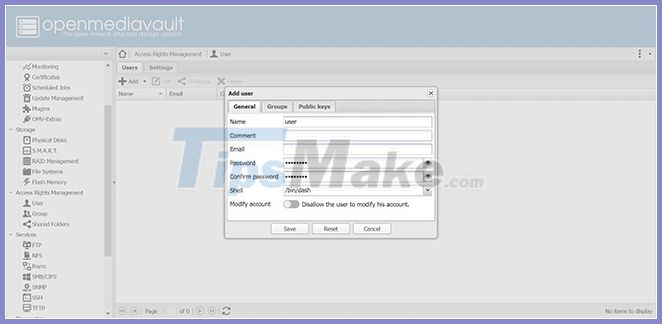 Add users
Add users
You can add multiple users to OpenMediaVault, which means you can set different permission levels for each person. To add users, click User under Access Rights Management on the main left menu. Click Add , give the user a name and password (you can also add things like an email address if you want) and remember to hit Apply.
Step 10: Access the file
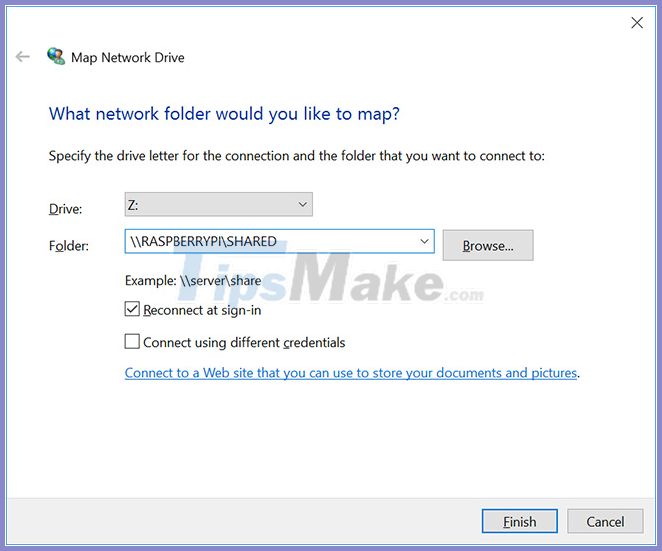
The article has covered everything you need to do with OpenMediaVault. Now, let's talk about the PC or Mac you are using to access these files. In either case, you will need to map a new shared memory from your computer.
On your PC, you'll need to use File Explorer. Click This PC , then click the Computer tab , then select Map Network Drive . You will need to select the drive letter from the drop-down box next to Drive - you can use any unused letter. In the Folder field , enter the path to the network storage drive. It will be RASPBERRYPI [folder] , where [folder] is the name of the shared folder. Click Finish and sign in using the credentials you created in step 8.
On a Mac, use Finder. Type Command + K to enter a window labeled Connect to Server . Enter smb: // raspberrypi in the Server Address field (you can also use an IP address instead of "raspberrypi"). Then click Connect , select the volume you want and click OK.
The NAS is now fully operational. Of course, this tutorial doesn't cover everything you can do with OpenMediaVault. To get the most out of the program, you should check out the OpenMediaVault wiki at:
https://openmediavault.readthedocs.io/en/5.x/You should read it
- 4 ways to set up Raspberry Pi as a media server
- How to turn a Raspberry Pi into an IRC server
- How to turn off WiFi of Raspberry Pi
- How to turn a Raspberry Pi into a WiFi Bridge
- How to turn Raspberry Pi into a personal cloud server
- How to turn Raspberry Pi into travel router with VPN
- How to add an ADC to Raspberry Pi: What you need to know
- Raspberry Pi Zero vs Model A and B, how are they different?
May be interested
- How to turn a Raspberry Pi into a wireless access point
 you are looking to create multiple indoor access points without any latency and connection issues often associated with using wifi extender. in this article, you will learn how to turn a raspberry pi into a wireless access point.
you are looking to create multiple indoor access points without any latency and connection issues often associated with using wifi extender. in this article, you will learn how to turn a raspberry pi into a wireless access point. - How to boot Raspberry Pi 4 from USB or over the network
 the raspberry pi is a wonderful, flexible piece of software, capable of a wide range of possibilities, from running a media center to using it as a radio.
the raspberry pi is a wonderful, flexible piece of software, capable of a wide range of possibilities, from running a media center to using it as a radio. - How to make a Raspberry Pi a web server
 today's article will show you how to turn a raspberry pi into a personal web server. at the end of this tutorial, you will learn how to install the apache web server on the raspberry pi, set up php and create a simple website to access over the local network.
today's article will show you how to turn a raspberry pi into a personal web server. at the end of this tutorial, you will learn how to install the apache web server on the raspberry pi, set up php and create a simple website to access over the local network. - Turn your Raspberry Pi into a Mac or PC with Twister OS
 if you are bored with the raspberry pi's default desktop, you can try a different distro or desktop. but if you want something more familiar, twister os is there.
if you are bored with the raspberry pi's default desktop, you can try a different distro or desktop. but if you want something more familiar, twister os is there. - What is the Raspberry Pi and how is the Raspberry Pi used?
 you can use the raspberry pi as a computer because everything needed has been built in. its broadcom bcm2835 soc processor includes cpu, gpu, ram, microsd card slot, wi-fi, bluetooth and 4 usb 2.0 ports.
you can use the raspberry pi as a computer because everything needed has been built in. its broadcom bcm2835 soc processor includes cpu, gpu, ram, microsd card slot, wi-fi, bluetooth and 4 usb 2.0 ports. - How to start Raspberry Pi 3 from USB
 raspberry pi is a great, versatile software suite, with a variety of capabilities like running a media center or using as a radio.
raspberry pi is a great, versatile software suite, with a variety of capabilities like running a media center or using as a radio. - How to turn a Raspberry Pi 4 into an Edge Gateway
 if you're planning to transfer large amounts of data to the cloud, you can improve performance and response time by using the raspberry pi as the edge gateway.
if you're planning to transfer large amounts of data to the cloud, you can improve performance and response time by using the raspberry pi as the edge gateway. - Why should people try Raspberry Pi 4?
 the new raspberry pi 4 has been released, but do you need to upgrade? is raspberry pi 4 really offering more features than the previous raspberry pi 3 b +?
the new raspberry pi 4 has been released, but do you need to upgrade? is raspberry pi 4 really offering more features than the previous raspberry pi 3 b +? - Raspberry Pi AI Kit: Bring AI to Raspberry Pi
 the raspberry pi ai kit is essentially raspberry pi's new m.2 hat+ board integrated with the hailo-8l acceleration module.
the raspberry pi ai kit is essentially raspberry pi's new m.2 hat+ board integrated with the hailo-8l acceleration module. - Learn Pi Imager, How to Use Raspberry Pi Imager
 the raspberry pi foundation recently released a new application for recording sd cards for the raspberry pi. the new program, called raspberry pi imager, launches march 5, 2020.
the raspberry pi foundation recently released a new application for recording sd cards for the raspberry pi. the new program, called raspberry pi imager, launches march 5, 2020.










 How to set up VPN Surfshark on Raspberry Pi
How to set up VPN Surfshark on Raspberry Pi How to turn Raspberry Pi into a Bluetooth speaker
How to turn Raspberry Pi into a Bluetooth speaker How to turn Raspberry Pi into a personal cloud server
How to turn Raspberry Pi into a personal cloud server Create NAS network storage with Raspberry Pi and Samba
Create NAS network storage with Raspberry Pi and Samba How to install NordVPN on Raspberry Pi
How to install NordVPN on Raspberry Pi How to find the IP address of the Raspberry Pi
How to find the IP address of the Raspberry Pi